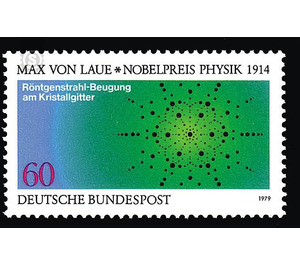Nobel laureate of physics and chemistry - Germany / Federal Republic of Germany 1979 - 60 Pfennig
Theme: Post & Philately
| Country | Germany / Federal Republic of Germany |
| Issue Date | 1979 |
| Face Value | 60.00 |
| Color | multi-colored |
| Perforation | K 14:14 1/4 |
| Printing Type | 4-color rotogravure |
| Stamp Type | Postage stamp |
| Item Type | Stamp |
| Chronological Issue Number | 908 |
| Chronological Chapter | GER-BRD |
| SID | 629721 |
| In 45 Wishlists | |
The special stamp series honors Nobel Prize winners Albert Einstein, Otto Hahn and Max von Laue. The Nobel Prize-winning works of the three scientists provided the motifs of the three commemorative stamps. Max von Laue was born on October 9, 1879 in Pfaffendorf near Koblenz. In 1909 he joined the Institute for Theoretical Physics of the University of Munich as a Privatdozent. Here he developed the idea of using X-rays to visualize the arrangement of the atoms in crystals. On the one hand, the experiment, successfully conducted in 1912, proved the wave character of the X-rays and, on the other hand, showed that crystals are indeed composed of atoms arranged with extreme regularity. Max von Laue was awarded the Nobel Prize for Physics of the Year 1914. Laue was a professor in Zurich, Frankfurt am Main, Berlin and Göttingen. Since 1951 he was director at the Fritz Haber Institute of the Max Planck Society in Berlin-Dahlem (formerly Kaiser Wilhelm Institute for Chemistry and Electrochemistry). Max von Laue died on April 24, 1960 in Berlin. (Text: Dr. Hermann Venghaus, German Physical Society e.V., Stuttgart)


